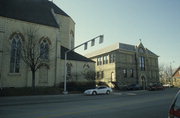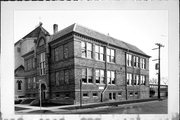Property Record
111 S MONTGOMERY ST
Architecture and History Inventory
| Historic Name: | St. Bernard's School |
|---|---|
| Other Name: | St. Bernard's School |
| Contributing: | |
| Reference Number: | 77138 |
| Location (Address): | 111 S MONTGOMERY ST |
|---|---|
| County: | Jefferson |
| City: | Watertown |
| Township/Village: | |
| Unincorporated Community: | |
| Town: | |
| Range: | |
| Direction: | |
| Section: | |
| Quarter Section: | |
| Quarter/Quarter Section: |
| Year Built: | 1892 |
|---|---|
| Additions: | |
| Survey Date: | 1986 |
| Historic Use: | school – elem/middle/jr high/high |
| Architectural Style: | Romanesque Revival |
| Structural System: | |
| Wall Material: | Cream Brick |
| Architect: | |
| Other Buildings On Site: | |
| Demolished?: | No |
| Demolished Date: |
| National/State Register Listing Name: | Saint Bernard's Church Complex |
|---|---|
| National Register Listing Date: | 11/26/2003 |
| State Register Listing Date: | 7/18/2003 |
| National Register Multiple Property Name: |
| Additional Information: | This building was the second and only remaining historic home of St. Bernard's Catholic School, one of four large parochial schools established in Watertown in the nineteenth century and still operating today. St. Bernard's Catholic School was founded shortly after the church was established in the 1840s. But it was not until 1857 that a permanent school building was built. The original frame building was designed by Louis Charbonneau, a local architect and was located on the current site. In 1892, this building was built and the original frame building was moved and eventually destroyed. This building housed the school until the 1950s, when a new school was built south of this location. Today the building is still being used as part of the elementary school complex. The old St. Bernard's School is significant for local history under National Register criterion A; it is the only remaining historic resource related to the development of parochial school education in Watertown. During Watertown's early years, public school development was slow and lacked public support. This lack of public support may have been caused by the proliferation of parochial schools in the 1840s and 1850s in Watertown, or the lack of adequate public school facilities may have fostered the growth of these parochial schools. Further, the highly German population in the community may have desired their own schools where their language and culture and religious beliefs could be taught to their children. In any event, by the late nineteenth century, two-thirds of Watertown's school children were being taught in parochial schools. The main parochial schools were at St. John's and St. Mark's Lutheran Churches (German schools), and St. Henry's Catholic Church (German school) and St. Bernard's Catholic Church. All the historic resources related to the early parochial schools in Watertown have been lost except for this building. Because of the importance of parochial school education in Watertown, and because these resources have been lost, save this building, the old St. Bernard's School is important to the history of education in Watertown. A large cream brick rectangular block constructed in 1892 on an elevated foundation and covered by a decked hip roof with bracketed eaves, the historic St. Bernard's School is further characterized by a two-story gabled entrance bay featuring round buttresses extending above the roof line, a round arched half window in the gable end and a round arched entrance with arched transom over double leafed door. Paired rectangular windows form a band on the side elevations and single rectangular windows (mostly filled in) are on the facade. The St. Bernard's School is significant under criterion C as an example of Romanesque Revival influenced vernacular architecture. One of two significant extant 19th century schools in the city, St. Bernard's School exhibits the characteristic round arched details associated with the Romanesque Revival although it is essentially a vernacular building. The other significant example of 19th century school architecture is Union School #3 at 505 Lincoln (21-29). Showing similar stylistic characteristics, Our Lady of the Sacred Heart College at 745 West Main (58-17) also is a significant example of a type of 19th century school or institutional architecture. |
|---|---|
| Bibliographic References: | (A) Building cornerstone. (B) Building inscription. (C) George T. Meagher, A Century at St. Bernard's, Milwaukee: St. Bernard's Church, 1946, pp. 19, 82, 137. (D) St. Bernard's newspaper subject file, Watertown Public Library. |
| Wisconsin Architecture and History Inventory, State Historic Preservation Office, Wisconsin Historical Society, Madison, Wisconsin |



